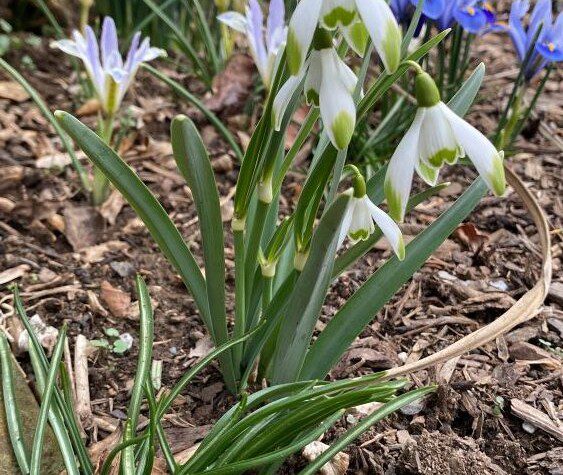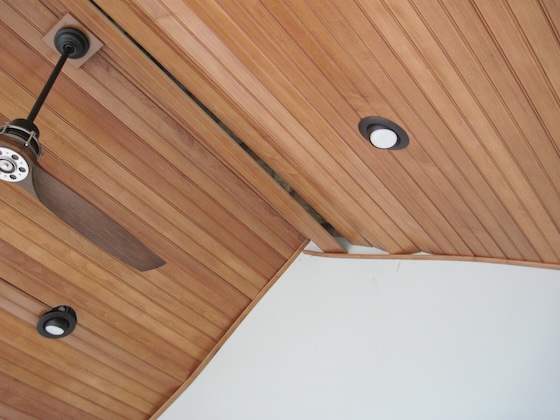

“The ideal fortune is to find an old garden, once richly cared-for, since sunk into neglect, and to tend, not repair, that neglect.”
Words from Scottish author Robert Louis Stevenson. How exciting would it be to discover a long-lost garden, overgrown but still recognisable as what it once was? There’s something very romantic about a lost garden, recognisable as a garden yet being reabsorbed by nature.
Stevenson was advocating the appreciation of neglect; to him the marriage of the wild and the cultivated was very appealing.
Gardens are not static. We see them as ‘still’ because the plant world moves at a different pace to ours, but every day there are subtle changes all around us. Plants slow down or might even stop altogether during winter, but once conditions are right the plant world starts moving again.

Ferns put out fronds very rapidly yet seem to take forever to actually get bigger
Without human intervention the less desirable plants, the weeds, take the opportunity to assert their dominance. Even ornamental plants, at least the ones that survive without constant attention, grow their own way without the gardener to assert authority. The abandoned garden quickly sheds the shackles of humanity and becomes a battleground as plants seek to dominate each other.
A garden doesn’t need to be neglected to change; change is a fundamental part of a garden. Plants are planted in the hope that they will grow bigger and develop rather than staying small. Over time the collective expansion of plants gently changes the nature of the garden, blocking out lines of sight and expanding out beyond their original spaces.
The idea of restoring old gardens is fashionable at the moment. Design companies offer their services to owners of large gardens who, for whatever reason, decide that they should return things to how they once were.
But is it actually possible to restore a garden?
You can restore an antique desk fairly easily. Gently remove layers of dirt, polish and paint and you will be left with the original fabric of the desk itself, as it was when it was made.
A desk exists in three dimensions.
A garden, however, exists in four dimensions: the normal three dimensions plus the effects of time. Time is constantly moving forwards and is impossible to reverse. A garden will change over the course of time but doesn’t ‘die’ as a whole unless it’s destroyed. Instead it grows, changes and evolves. By contrast the antique desk remains the same size and shape throughout its existence.

The walls and glasshouses at Tregrehan are the same size and shape as they were when built, but the garden has changed dramatically
Can you ‘reset’ a garden?
Even if you remove absolutely every single plant in the garden, replacing them with younger versions of the exact same plant in the exact same place, you haven’t restored the garden. Surviving buildings and features can be made ‘as new’ and paths scraped back to their original levels, but in the case of the plants you have just replaced one garden with another, albeit one that is faithful to the original plan. Even replacing everything you cannot escape the fact that your recreation exists in a the modern era.
Should old gardens simply mature and develop organically, or whether we should try to freeze gardens in time?
I have two examples from two wonderful gardens in my region of Britain.
The lawn at Trewithen
There has been a strip of lawn to the rear of the house at Trewithen since at least 1747. The nature of the garden has changed significantly over time but this area has largely remained as it is. From the second half of the 20th century the garden’s collection of Rhododendrons, Magnolias and other woody plants have expanded outwards and blurred the edges; over time the straight lawn became curved in one direction instead of following the original line. While I don’t have a photograph along the length of the lawn, you can see from the picture below that the edges of the lawn were stuffed with woody plants.

The lawn at Trewithen as it once was, lined with trees and shrubs
The decision was taken to restore the straight line. As you can see this was a rather dramatic change!

A view back to the house after extensive work to clear the area
The plants from this area were propagated and new examples planted elsewhere to keep them as part of the collection, and the original 1747 lines have returned. The disastrous loss of some trees during ‘The Beast From The East’ (an anticyclone that brought strong winds and bitter cold to northern parts of Europe in 2018) impacted on the decision to carry out this project; the level of damage meant that there was a need to carry out extensive repair work to the garden, so the restoration plan seemed a logical step to take at that point.
The yew tunnel at Tregrehan
A few miles away from Trewithen is another wonderful old Cornish garden at Tregrehan. At some point in the history of the garden a ‘yew walk’, flanked with Taxus baccata ‘Fastigiata’, was planted. Over many decades the pillars of Taxus flopped outwards, and where the branches met in the middle they formed a rather enchanting tunnel

The yew tunnel at Tregrehan
It would be possible to cut these trees back and restore them to their former glory, but the decision was taken at Tregrehan not to because the tunnel effect is deemed desirable. While a ‘yew walk’ would be an interesting garden feature there is something dramatic about a tunnel of trees.
For the time being the owners of Tregrehan are happy to see what they have as part of the evolution of the garden.
So who’s right, Trewithen or Tregrehan?
Two very different approaches to ‘restoration’, with one garden taking a fairly hard ‘reset’ while the other opted to embrace what it had.
Neither approach is particularly ‘right’ or ‘wrong’. At Tregrehan there is a possibility that one day the branches of their yew walk might fail, forcing the need for some serious pruning. At Trewithen the work has dramatically altered the nature of the garden; if nothing else the incredible display of colour they could admire from their windows each spring has gone!
What both gardens have in common is that what they have now is not original. The yew trees at Tregrehan aren’t the pillars originally intended, while the lawn at Trewithen is a reimagining, a recreation, of what was there originally rather than a return to its original form.

Vibrant greens and white in May; there’s more to an old garden than historical accuracy
Living things, including gardens, are swept along with the passing of time. It’s good to embrace the timelessness of gardens while also accepting there is sometimes a need, or just a good case for, bold changes. Historic gardens are simultaneously old and new, with old plants and new plants contributing to the garden as it exists right now; it’s important to value both the past and present of the garden, especially when making plans for the future.
Restoration vs Renovation originally appeared on GardenRant on April 24, 2023.
The post Restoration vs Renovation appeared first on GardenRant.





More Stories
Why Should We Think About Our Winter Gardens Right Now?
5 Reasons You Need Snow Removal Services
Green Industry Veteran Nick Jiannas Joins Kress Commercial